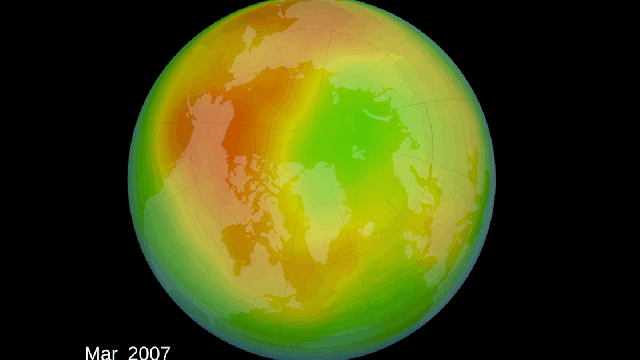The ozone hole is the problem that never seems to ever go away. And now it turns out we have a second one to worry about over the Arctic.
The ozone hole we all know and love (or more accurately, hate) has been smallest hole on record over the Antarctic where it traditionally forms.
We’ve certainly done enough to make a bad situation better, but weather is driving some of the recent recovery. But it’s also weather”the polar vortex in particular”that’s driving a new, rare hole in the ozone layer to open up over the Arctic.
Ozone levels in the atmosphere above the South Pole fluctuate throughout the year. The amount of chemicals we emit has everything to do with that. Humans have yet to properly reduce our use of chlorofluorocarbons and hydrochlorofluorocarbons, the groups of greenhouse gases found in old air conditioners and refrigerants that cause ozone depletion in the atmosphere.
But the region’s weather conditions also play a role. That’s because the reaction between these chemicals, cold temperatures, and sunlight is what diminishes our much-needed ozone layer. The ozone layer helps keep out dangerous ultraviolet radiation from reaching the Earth’s surface, raising the risk of skin cancer and other maladies.
However, this chemical reaction rarely happens over the North Pole. The Antarctic is generally colder than the Arctic. Temperature in spring there regularly drop to levels that can influence ozone depletion even while the sun’s out. In the Arctic, spring temperatures are usually warmer and more variably owing to the (relatively) moderating influence of the Arctic Ocean, which makes ozone-depleting chemical reactions harder to come by.
This year was different, though. The polar vortex stayed locked in over the Arctic, where cold air gathered, creating the perfect recipe for a hole in the ozone layer to form. The strong polar vortex staying up in the Arctic is, incidentally, why this winter was so mild in the U.S. and other places that have dealt with its incursions in recent years.
In 2011, a similar hole formed over the Arctic due to a mix of factors, including cold temperatures, a stagnant atmosphere, and ozone-depleting chemicals. That year saw this same dangerous mix, but that ozone hole was still pretty small compared to the damage the Antarctic sees. This time, unfortunately, the hole may be bigger. And while ozone depletion”measured by something called Dobson Units”isn’t as intense as it is in the Antarctic, it’s still quite an oddity to have a hole over the Arctic. The smaller the number, the worse the hole. In the Arctic, there are still enough chemicals in the atmosphere to deplete the ozone further.
Until then, scientists are keeping their eyes on the hole. It’s a rare event, but one made worse by our actions. The more dangerous chemicals we emit into the atmosphere, the worse these random events grow.
